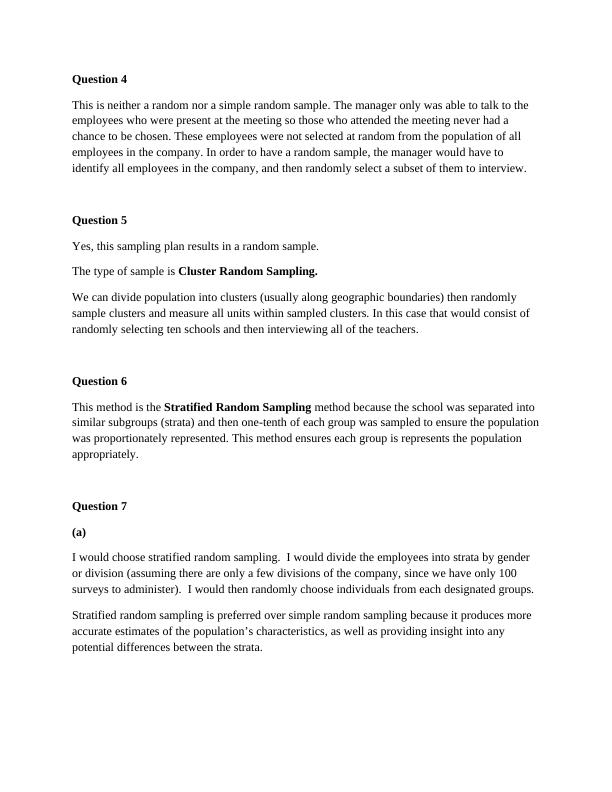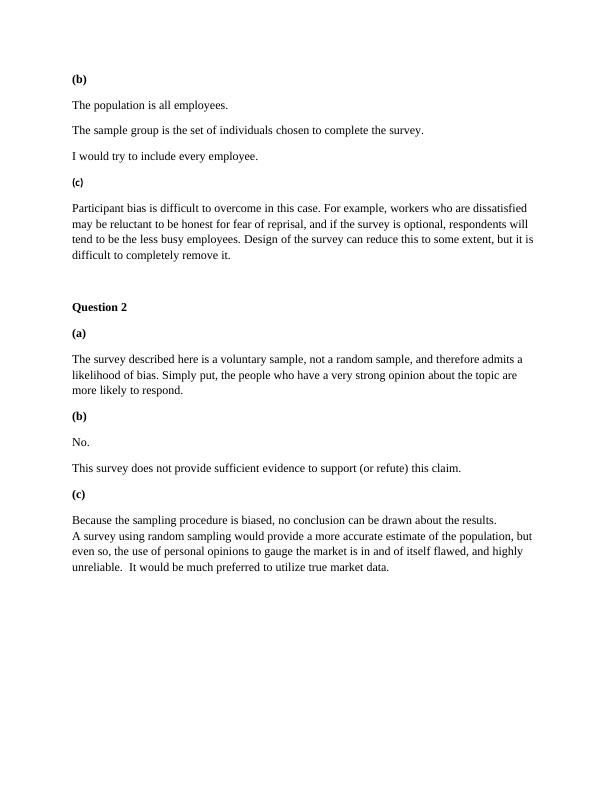Ask a question from expert
Sampling, Hypothesis Testing, and Regression
8 Pages1706 Words608 Views
Added on 2019-10-18
Sampling, Hypothesis Testing, and Regression
Added on 2019-10-18
BookmarkShareRelated Documents
Sampling, Hypothesis Testing, and RegressionQuestion 1Simple Random SamplingA simple random sample is a subset of a statistical population in which each member of the subset has an equal probability of being chosen. An example of a simple random sample would be the names of 10 employees being chosen using a lottery method from a company of 100 employees. In this case, the population is 100 employees, and the sample is random because eachemployee has an equal chance of being chosen.Advantages:1.The method is simple to use.2.This method is an unbiased representation of a group.3.This is suitable for data analysis which includes the use of inferential statistics.Disadvantages:1.Asampling errorcan occur with a simple random sample if the sample does not end up accurately reflecting the population it is supposed to represent. For example, in our simple random sample of 10 employees, it would be possible to draw 10 men even if the population consisted of 50 women and 50 men.2.It cannot be employed where the units of population are heterogeneous in nature.3.This method lacks the use of available knowledge concerning the population.Question 2This is a case of Simple Random Sampling because the names are drawn at random and has an equal probability of being selected.Question 3Yes, this sampling plan results in a random sample.The type of sample is Systematic Random Sampling.This sample is systematic random sampling as it does not involve separate random selection of each household and is used to select large samples from a long list of households.

Question 4This is neither a random nor a simple random sample. The manager only was able to talk to the employees who were present at the meeting so those who attended the meeting never had a chance to be chosen. These employees were not selected at random from the population of all employees in the company. In order to have a random sample, the manager would have to identify all employees in the company, and then randomly select a subset of them to interview.Question 5Yes, this sampling plan results in a random sample.The type of sample is Cluster Random Sampling.We can divide population into clusters (usually along geographic boundaries) then randomly sample clusters and measure all units within sampled clusters. In this case that would consist of randomly selecting ten schools and then interviewing all of the teachers.Question 6This method is the Stratified Random Sampling method because the school was separated into similar subgroups (strata) and then one-tenth of each group was sampled to ensure the populationwas proportionately represented. This method ensures each group is represents the population appropriately.Question 7(a)I would choose stratified random sampling. I would divide the employees into strata by gender or division (assuming there are only a few divisions of the company, since we have only 100 surveys to administer). I would then randomly choose individuals from each designated groups. Stratified random sampling is preferred over simple random sampling because it produces more accurate estimates of the population’s characteristics, as well as providing insight into any potential differences between the strata.

(b) The population is all employees. The sample group is the set of individuals chosen to complete the survey. I would try to include every employee.(c)Participant bias is difficult to overcome in this case. For example, workers who are dissatisfied may be reluctant to be honest for fear of reprisal, and if the survey is optional, respondents will tend to be the less busy employees. Design of the survey can reduce this to some extent, but it is difficult to completely remove it.Question 2(a)The survey described here is a voluntary sample, not a random sample, and therefore admits a likelihood of bias. Simply put, the people who have a very strong opinion about the topic are more likely to respond.(b)No. This survey does not provide sufficient evidence to support (or refute) this claim.(c)Because the sampling procedure is biased, no conclusion can be drawn about the results. A survey using random sampling would provide a more accurate estimate of the population, but even so, the use of personal opinions to gauge the market is in and of itself flawed, and highly unreliable. It would be much preferred to utilize true market data.

End of preview
Want to access all the pages? Upload your documents or become a member.
Related Documents
Sampling, Hypothesis Testing, and Regressionlg...
|8
|1706
|278
Grounds for Probability and Non-Probability Sampling Case Study 2022lg...
|5
|1042
|22
Business Research Methodologylg...
|6
|893
|274
Finance Testlg...
|12
|1336
|210
Sampling: Meaning, Importance, and Methods of Samplinglg...
|2
|547
|57
Evaluating Sampling Methods and Sample Size | Caseslg...
|13
|3099
|16